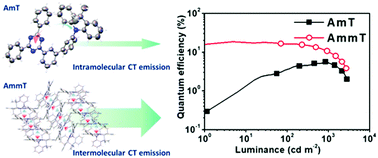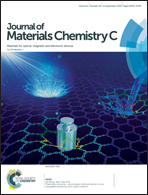Non-doped thermally activated delayed fluorescent organic light-emitting diodes using an intra- and intermolecular exciplex system with a meta-linked acridine–triazine conjugate†
Abstract
We report OLEDs utilizing non-doped TADF emitters, 10-(3-(4,6-diphenyl-1,3,5-triazin-2-yl)phenyl)-9,9-dimethyl-9,10-dihydroacridine (AmT) and 10-(3′-(4,6-diphenyl-1,3,5-triazin-2-yl)-[1,1′-biphenyl]-3-yl)-9,9-dimethyl-9,10-dihydroacridine (AmmT). These two emitters are composed of electron donor (acridine) and acceptor (triphenyltriazine) moieties, which are connected at the meta positions so that intra- and intermolecular charge transfer (CT) states can be induced through exciplex-like interactions between the same emitters. A neat film of AmmT forms intermolecular CT state-induced exciplexes more favorably than AmT because of the packing benefits and relatively shorter radiative lifetime of AmmT. Electroluminescent devices using AmmT as an emitter exhibit an external quantum efficiency (EQE) over 18%, which is much better than the EQE value for devices using AmT. This is the first example of a non-doped TADF system using a single molecule-based exciplex as a dominant exciton source.



 Please wait while we load your content...
Please wait while we load your content...